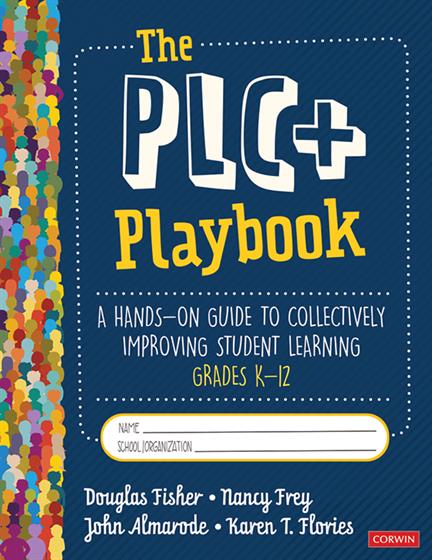List of Videos
About the Authors
Acknowledgments
Welcome to the PLC+ Playbook
Module 1: The Purpose and Status of Your PLC+
Put the Playbook to Work for You
PLC Defined
PLC+ Guiding Questions
Module 2: Crosscutting Values and Opportunities to Grow Your PLC+ Team
Put the Playbook to Work for You
Crosscutting Values
SWOT Analysis
Module 3: On Your Own: The Plus Is You
Put the Playbook to Work for You
Your Individual Identity
Teacher Credibility
Teacher Credibility and Its Intersection With Crosscutting Values
Teacher Self-Efficacy
Teacher Self-Efficacy and Its Intersection With Crosscutting Values
Module 4: Collective Efficacy and Credibility in a PLC+
Put the Playbook to Work for You
Revisiting Teacher Credibility and Teacher Self-Efficacy
From Individual to Collective Teacher Efficacy
Setting Norms for Our Ways of Work
Norms for Our Ways of Work in Our PLC+
Module 5: Guiding Question 1: Where Are We Going? Analyze Standards
Put the Playbook to Work for You
Analyzing Standards
Design the Learning Progression
Develop Daily Learning Intentions
Identify Success Criteria
Complete PLC+ Template for Guiding Question 1: Where Are We Going?
Module 6: Where Are We Going? Crosscutting Values Check
Put the Playbook to Work for You
Equity and Expectations Values Checklist
Activate Learning for Myself and Others Checklist
Collective Efficacy Checklist
Module 7: Guiding Question 2: Where Are We Now? Data Collection
Put the Playbook to Work for You
Initial Assessment Data Collection
Data Gathering
Module 8: Where Are We Now? Data Analysis, Common Challenges, and Misconception Analysis
Put the Playbook to Work for You
Data Analysis Protocol
Common Challenge Protocol
Identify Student Misconceptions
Module 9: Where Are We Now? Crosscutting Values Check
Put the Playbook to Work for You
Equity and Expectations Values Checklist
Activate Learning for Myself and Others Checklist
Collective Efficacy Checklist
Module 10: Guiding Question 3: How Do We Move Learning Forward? Strengthening Our Teaching Practices
Put the Playbook to Work for You
Pair Teaching Strategies With Evidence Gathering
Coaching Corners Protocol
Module 11: How Do We Move Learning Forward? Assignment Analysis
Put the Playbook to Work for You
Assignment Analysis Tool
Module 12: How Do We Move Learning Forward? Learning Walks
Put the Playbook to Work for You
What Is a Learning Walk?
Types of Learning Walks and Their Purposes
Module 13: How Do We Move Learning Forward? Microteaching
Put the Playbook to Work for You
Microteaching in a Professional Learning Community
Preparation for Microteaching: The Volunteer Teacher
Module 14: How Do We Move Learning Forward? Crosscutting Values Check
Put the Playbook to Work for You
Equity and Expectations Values Checklist
Activate Learning for Myself and Others Checklist
Collective Efficacy Checklist
Module 15: Guiding Question 4: What Did We Learn Today?
Put the Playbook to Work for You
Build the Habit of Reflection
Module 16: What Did We Learn Today? Build Expert Noticing
Put the Playbook to Work for You
Expert Noticing: How Is Our PLC+ Using Student Evidence of Learning?
Expert Noticing Video Protocol
Noticing Note-Taking Guide
Module 17: What Did We Learn Today? Common Assessments
Put the Playbook to Work for You
Common Assessments/Quality Assessment Evidence
Design a Common Assessment to Use for Preunit and Postunit Comparisons
Module 18: What Did We Learn Today? Determining Impact and Comparing Progress and Achievement
Put the Playbook to Work for You
Determining Impact
Progress Versus Achievement
Visualizing Data
Module 19: What Did We Learn Today? Crosscutting Values Check
Put the Playbook to Work for You
Equity and Expectations Values
Overcoming Obstacles to Talking About Learning
Equity and Expectations Values Checklist
Activate Learning for Myself and Others Checklist
Collective Efficacy Checklist
Module 20: Guiding Question 5: Who Benefited and Who Did Not Benefit?
Put the Playbook to Work for You
On Your Own
Data Review
On Your Own
Equity Audit Protocol: Revisit the Data as a Team
Module 21: Who Benefited and Who Did Not Benefit? Responding to Improve Student Learning
Put the Playbook to Work for You
The Vital Nature of Progress Monitoring
Tiered Intervention Progress Monitoring Protocol
Module 22: Who Benefited and Who Did Not Benefit? Crosscutting Values Check
Put the Playbook to Work for You
Equity and Expectations Values Checklist
Activate Learning for Myself and Others Checklist
Collective Efficacy Checklist
References







